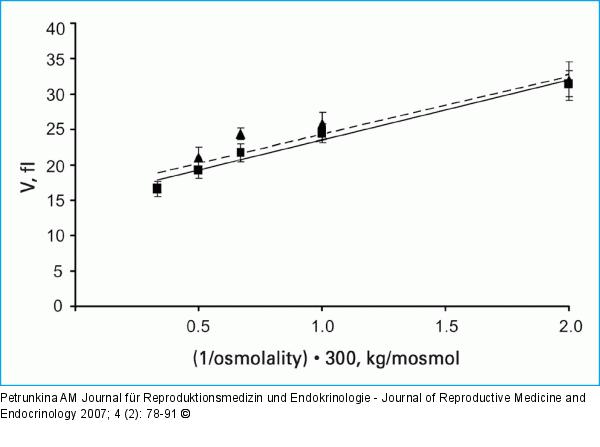Petrunkina AM Fundamental Aspects of Gamete Cryobiology Journal für Reproduktionsmedizin und Endokrinologie - Journal of Reproductive Medicine and Endocrinology 2007; 4 (2): 78-91 Volltext (PDF) Summary Übersicht
| ||||
Abbildung 1: Boyle Van't Hoff Plot Boyle Van’t Hoff Plot of boar spermatozoa (Drawn on the basis of data presented in [22]). Data are presented in volume equivalents for ejaculated (unbroken line) and epididymal (broken line) boar spermatozoa at 39°C as measured by electronic cell counter. Boar spermatozoa behave as "perfect osmometers" in the range between 150–900 mOsmol/kg. The changes in aniso-osmotic volume V are given by the regression equation where x is the reciprocal of relative osmolality: • for epididymal spermatozoa, V = 8.2• x +16.2 where x = 1/300 mOsmol/kg R2 = 0.94 • for ejaculated spermatozoa, V = 8.5• x +15.1 where x = 1/300 mOsmol/kg R2 = 0.99 The osmotically inactive fraction of cell volume corresponds to 0.645•Viso in epididymal spermatozoa and to 0.626•Viso in ejaculated spermatozoa. |

Abbildung 1: Boyle Van't Hoff Plot
Boyle Van’t Hoff Plot of boar spermatozoa (Drawn on the basis of data presented in [22]). Data are presented in volume equivalents for ejaculated (unbroken line) and epididymal (broken line) boar spermatozoa at 39°C as measured by electronic cell counter. Boar spermatozoa behave as "perfect osmometers" in the range between 150–900 mOsmol/kg. The changes in aniso-osmotic volume V are given by the regression equation where x is the reciprocal of relative osmolality: • for epididymal spermatozoa, V = 8.2• x +16.2 where x = 1/300 mOsmol/kg R2 = 0.94 • for ejaculated spermatozoa, V = 8.5• x +15.1 where x = 1/300 mOsmol/kg R2 = 0.99 The osmotically inactive fraction of cell volume corresponds to 0.645•Viso in epididymal spermatozoa and to 0.626•Viso in ejaculated spermatozoa. |


